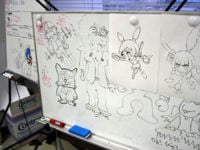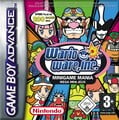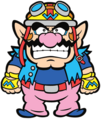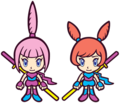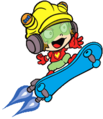WarioWare, Inc.: Mega Microgame$!: Difference between revisions
m (→Development) |
m (added link to staff) |
||
| Line 171: | Line 171: | ||
*''[http://www.gamespot.com/gba/puzzle/warioware/review.html Gamespot.com's] Jeff Gerstmann'' stated that the combination of mini-games and pacing of puzzle games such as ''[[wikipedia:Tetris|Tetris]]'' came together in a wonderful way. (9.1/10) | *''[http://www.gamespot.com/gba/puzzle/warioware/review.html Gamespot.com's] Jeff Gerstmann'' stated that the combination of mini-games and pacing of puzzle games such as ''[[wikipedia:Tetris|Tetris]]'' came together in a wonderful way. (9.1/10) | ||
*''[http://gameboy.ign.com/articles/410/410028p1.html IGN.com's] Craig Harris'' loved WarioWare and stated that it did not matter that the main quest only took one or two hours. The additional replay value made up for it. He also sighted the game's "pick up and play" qualities as reasons for his high score. (9/10) | *''[http://gameboy.ign.com/articles/410/410028p1.html IGN.com's] Craig Harris'' loved WarioWare and stated that it did not matter that the main quest only took one or two hours. The additional replay value made up for it. He also sighted the game's "pick up and play" qualities as reasons for his high score. (9/10) | ||
== Staff == | |||
{{main|WarioWare, Inc.: Minigame Mania Staff}} | |||
==Media== | ==Media== | ||
Revision as of 12:46, May 7, 2009
Template:Infobox WarioWare, Inc.: Minigame Mania, known as WarioWare, Inc.: Mega Microgame$! in North America and as Made in Wario (メイド イン ワリオ Meido in Wario) in Japan, is a game for the Game Boy Advance and the first title in the critically acclaimed WarioWare series of games. It was released on March 21, 2003 in Japan, later that year in Western territories and in 2005 in China. The game focuses on very short mini-games, so-called microgames, which only last for a few seconds each. The game's plot centers around Wario who founds a game company and creates a video game along with his friends, an entirely new cast of characters introduced in Minigame Mania.
Widely considered to be one of the most innovative games of its generation, Minigame Mania created a new genre of games. It was praised by critics for its very weird and fun feel that further sets it apart from other games.
Story
One day while lounging on the couch, Wario sees a report from Ken the Reporter on TV about a video game (Pyoro) that has made tons of money. It doesn't take long for Wario's head to fill with thoughts of all of the cash he could get if he made a video game. Quickly, he sits on his bike to obtain a laptop. Wario's House gets replaced with the headquarters of WarioWare, Inc., Wario's newly founded "company." After trying to make a video game by himself, Wario grows lazy and calls up his closest friends to help. They happily agree. This game is their labor of love. Since Wario doesn't want to spend too much money on the game, they develop a lot of simple microgames rather than a single full-fledged game.
WarioWare, Inc. becomes a commericial success. Wario ends up swindling his employees, though, refusing to pay them and taking all of the money for himself. In the WarioWare, Inc. headquarters, he runs away from his employees with the cash and escapes with a rocket attached to the building. However, Dr. Crygor flying with his jet pack accidentally bumps the rocket and causes it to fall down into the sea along with Wario and the banknotes.
Gameplay
The game is based around the concept of playing very quick, simple microgames (over 200 in all) in rapid succession. After beating a certain number of these microgames, the speed will increase, and sometimes the difficulty level of the individual games as well. If a player is good enough, the game will eventually spew out a new microgame about every four seconds. The game includes both modes with a set number of games to finish and arcade-style modes where the player aimes for a high score. This concept in a much simpler form with only eight microgames in total was first used in Mario Artist: Polygon Studio in the Sound Bomber mode.
Games Mode
The Games mode can be referred to as the Story mode. There are nine stages hosted by the different characters from the game that come with their own set of microgames based around a certain theme each. Two special stages that are comprised of microgames from several specific sets are included as well. Each of the eleven stages must be beaten to progress through the story. All stages feature cutscenes that are centered on the respective character, which are viewed before the actual gameplay. The epilogue of the story shows up after the player beat the stage.
To beat a given set, players must beat a certain number of the games specific to that set without fail. The last game to beat is the boss stage, a complexer game without a strict time limit. Players are given fourth lives at most, but when a game is failed, the player loses one. Losing all lives resulsts in a Game Over. By winning a boss stage, the player gains an extra life if he or she has less than four lives. Seeing a microgame in the Games mode opens it up for free play in the Grid mode.
After beating a stage, it turns into a challenge to see how long the player can last. Then the game continues after every boss stage on a higher difficulty level. After beating the boss stage on the third level and every next time, the speed increases additionally instead. The stages do not need to be beaten again, but some extra content is only unlockable by getting a minimum high score on a character's stage.
Grid Mode
In this mode, players can play any microgame they have encountered in the Games mode. However, this mode also allows competitive players to challenge the game. When selected, a single challenge will be fired at the player over and over until they miss four times. The game goes through a three-microgame difficulty cycle, with the first one being easy, the next being of normal difficulty, and the third being hard. After that, the speed of the game increases and the difficulty cycle begins anew. When getting a minimum score on a game (at most 25 points, depending on the game), the player earns a red flower for this game.
Extra Content
By playing the Games and Grid modes, extra challenges can be unlocked. These include special mini-games for one or two players, and mixes of the microgames from all sets.
The single player challenges feature special mini-games, partly beefed up versions of the microgames. There are also dual-player games which allow for two people to play four simple mini-games using only one Game Boy Advance. The first player uses the L button while the second player uses the R button.
Finally, there are the tower stages that are the last unlocked stages and challenge players beating as many of the microgames as possible before a certain objective is met. All of the microgames are put into the mix. For example, one tower challenges players to not miss a single of the hard versions of the microgames.
Characters
Major Characters
Other Characters
- Ken the Reporter
- Pyoro
- Gelato Joe
- Mona's Elephant
- Mona's Piggy
- Mona's Chimp
- Diamond Police
- Shag
- Fronks
- Space Hares
- Paw the Dog
- Don the Sparrow
- Ana's Crew
- Boneheads
Games
Microgames
There are nine different sets of microgames, each one created by one or two WarioWare developers and focused on a special theme.
- Introduction – Wario
- Sports – Jimmy T.
- Strange – Mona
- Sci-Fi – Dribble and Spitz
- Nintendo Classics – 9-Volt
- Reality – Dr. Crygor
- IQ – Orbulon
- Nature – Kat and Ana
- Anything Goes – Wario
Besides the single sets, there are also six extra microgame modes involving the microgames from more than one character. Two of them are Remixes of Jimmy T. and need to be beaten to unlock three or one new character. The other ones are hosted at four different towers located in Diamond City, all with pig sculptures and pig heads on the elevator's doors.
- Jimmy's Remix 1 (unlockable by beating the stages of Mona, Dribble, Spitz, and 9-Volt): A mix of the microgames of Jimmy himself and the named characters. However, Jimmy's boss stage "Punch Out" is the only boss stage to appear. The games start already on the middle difficulty level.
- Jimmy's Remix 2 (unlockable by beating the stages of Dr. Crygor, Orbulon, Kat, and Ana): A mix of the microgames of the named characters. Again, only Jimmy's boss stage is featured and the games start on the middle difficulty level.
- Easy (unlockable by beating Wario's second stage): The microgames of all characters on the lowest difficulty level randomly appear, except for the boss stages, meaning that no 1-Ups can be earned.
- Total Boss (unlockable by beating Wario's second stage): Only the boss stages appear in this mode in a constant order. After beating all eight boss stages, it starts the first again and the level will increase like in the microgame sets of the developers.
- Thrilling (unlockable by getting 15 or more points in Easy): Mostly the same as Easy, but all games are on a very high speed.
- Hard (unlockable by getting 15 or more points in Thrilling): The speed is normal again, but all games are on the third difficulty level and only one life is available, meaning the game is over after only one lost microgame.
Bonus Mini-Games
Besides the microgames, also mini-games without a strict time limit can be unlocked. They are mostly beefed up versions of the microgames. Some of these games also involve other WarioWare developers than Wario, in the microgames only Wario is featured in his own games. There are also a bit altered altered ports of old Nintendo games.
Single Player
The highest score will be saved in all of these games.
Dual-Player
In all of these games, one player has to press the L button while the other one has to press the R button. Unlike the single-player games, there are no high scores, a game just ends after one player has earned the necessary points and won.
Locations
- Diamond City
- Outer Space
Objects
There are so many objects over the course of the microgames, but they only appear for seconds. Here are the objects that seem to stand out and play an important role.
- Wario Bike
- Wario's Laptop
- Wario Bomb
- Jimmy T.'s Cell Phone
- Mona's Scooter
- Dribble and Spitz's Cab
- 9-Volt's Skateboard
- Orbulon's UFO
- Kat and Ana's Swords
Development
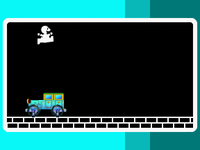
The WarioWare concept with very short mini-games coming one after another was first used in Mario Artist: Polygon Studio, a game released for the Nintendo 64DD in 2000 only in Japan. The game's so-called Sound Bomber includes eight microgames, six of the microgames in WarioWare, Inc.: Minigame Mania are based on those.[1]
Made in Wario, as the game is known in Japan, was originally made secretly by a number of developers on the development team Nintendo R&D1 without telling their manager at the time. The people came up with the idea of using Wario for the game since they couldn't think of anyone else who would be best for the game. According to them, Wario is "always doing stupid things" and is "really idotic", so they used him and the other newly created characters, who have become a recurring cast in the series.[2]
Being convinced by their work, the makers presented their idea to their manager at a certain point. He didn't seem to be surprised and just gave his okay, so the people continued the development.[2]
For the creation of the microgames, each person on the team came up with their own ideas, which were wrote down on notes and attached to the director's table. After this, the people went through the ideas to decide which ones could be included in the final product. Since the game became well-known around the department, even people who weren't on the project started to submit their own ideas. Because each of the programmers created their own graphics during the development of the games, the art style is very different with each microgame.[2]
Made in Wario or WarioWare, as the franchise is called in the West, was first announced by Nintendo in early January 2003[3] and originally released in March 2003 in Japan. Nintendo didn't have hugely high commercial hopes for the game. However, the game's sales figures were growing and growing and it gained a very good reputation.[4]
Since WarioWare, Inc.: Minigame Mania was commercially successful, Satoru Iwata, president of Nintendo, requested a remake of the original WarioWare, Inc. for the Nintendo GameCube that had to be finished "as soon as possible." The development resulted in the first sequel, WarioWare, Inc.: Mega Party Game$!, which focuses on mutliplayer and came out in Japan only a half a year later after the first game.[5] It is also the first WarioWare game that was co-developed by Intelligent Systems.[6] More WarioWare sequels have followed since, which mostly make use of a new piece of Nintendo's hardware, and so WarioWare has become one of Nintendo's headliner titles whenever they bring out new hardware.[7]
Critical Reception
Overall, the critic's reviews were positive. Gamerankings.com's overall score for the game is 89%.
- 1up.com's Shane Bettenhausen loved how fast-paced and frantic the game was. He also stated that playing the games was all it took to convince his friends of the game's value. He also enjoyed the weirdness of the game. (9.5/10)
- Gamespot.com's Jeff Gerstmann stated that the combination of mini-games and pacing of puzzle games such as Tetris came together in a wonderful way. (9.1/10)
- IGN.com's Craig Harris loved WarioWare and stated that it did not matter that the main quest only took one or two hours. The additional replay value made up for it. He also sighted the game's "pick up and play" qualities as reasons for his high score. (9/10)
Staff
- Main article: WarioWare, Inc.: Minigame Mania Staff
Media
Logos and Box Art
- WarioWare MM JAP logo.png
Japanese logo - WarioWare MM JAP cover.jpg
Japanese box art - WWMM boxart.jpg
North American box art
Character Artwork
Main Pictures
- Jimmy T. WarioWare Mega Microgames.png
- Orbulon WarioWare Mega Microgames.png
Other Pictures
Wario with Wario Bike Wario with Laptop - Jimmy T. 2 WarioWare Mega Microgames.png
Jimmy T. with Cell Phone - Dr. Crygor 2 WarioWare Mega Microgames.png
- Ana and Shadow WarioWare Mega Microgames.png
Paw the Dog and Ana
Names in Other Languages
References
- ^ Warioware, Inc.: Mega Microgame$! at NinDB
- ^ a b c Nintendo R&D1 Interview (page 2) at Kikizo
- ^ News "New Mario and Wario GBA Games" at IGN
- ^ Iwata Asks: Wii, Volume 1 - WarioWare: Smooth Moves (page 4) at Nintendo of Europe's Wii Portal
- ^ Iwata Asks: Nintendo DSi, Volume 1 - WarioWare: Snapped! (page 1) at NintendoDSi.com
- ^ Intelligent System's games at their official site
- ^ Iwata Asks: Nintendo DSi, Volume 1 - WarioWare: Snapped! (page 3) at NintendoDSi.com

